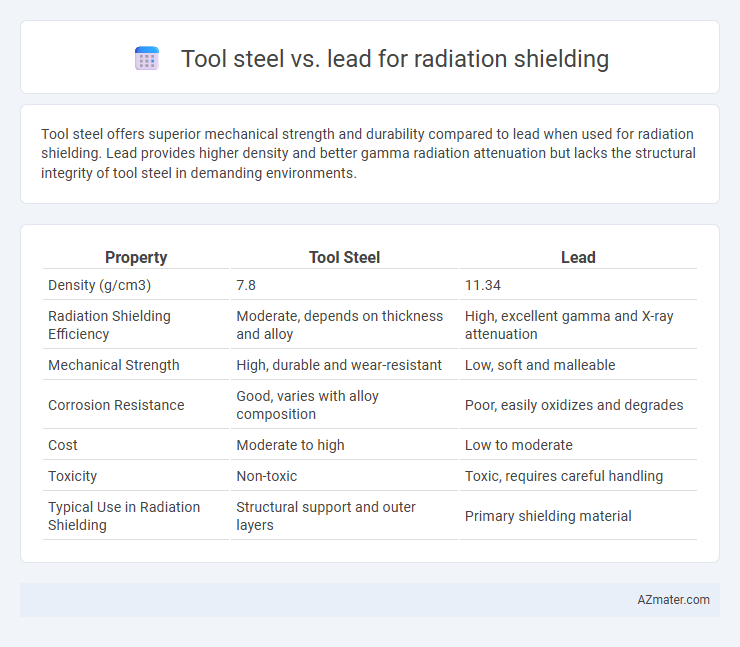Tool steel offers superior mechanical strength and durability compared to lead when used for radiation shielding. Lead provides higher density and better gamma radiation attenuation but lacks the structural integrity of tool steel in demanding environments.
Table of Comparison
| Property | Tool Steel | Lead |
|---|---|---|
| Density (g/cm3) | 7.8 | 11.34 |
| Radiation Shielding Efficiency | Moderate, depends on thickness and alloy | High, excellent gamma and X-ray attenuation |
| Mechanical Strength | High, durable and wear-resistant | Low, soft and malleable |
| Corrosion Resistance | Good, varies with alloy composition | Poor, easily oxidizes and degrades |
| Cost | Moderate to high | Low to moderate |
| Toxicity | Non-toxic | Toxic, requires careful handling |
| Typical Use in Radiation Shielding | Structural support and outer layers | Primary shielding material |
Introduction to Radiation Shielding Materials
Radiation shielding materials vary significantly in composition and effectiveness, with tool steel and lead representing two common options. Tool steel offers structural strength and moderate radiation attenuation, particularly suitable for mechanical protection in shielding assemblies. Lead remains the preferred material due to its high density and atomic number, providing superior gamma and X-ray attenuation in compact, cost-effective shielding designs.
Overview of Tool Steel and Lead
Tool steel exhibits high tensile strength and durability, making it suitable for structural applications but less effective in radiation shielding due to its lower density compared to lead. Lead is a dense, malleable metal with excellent radiation attenuation properties, widely used in medical and nuclear shielding to protect against X-rays and gamma rays. While tool steel offers mechanical robustness, lead remains the preferred material for shielding because of its superior ability to absorb and block ionizing radiation.
Physical and Chemical Properties
Tool steel offers superior mechanical strength and heat resistance compared to lead, making it more durable in high-stress environments. Lead's high density (11.34 g/cm3) and atomic number (82) provide excellent radiation attenuation, particularly for gamma rays, due to its effective photon absorption properties. Chemically, tool steel is an alloy primarily of iron with carbon and other elements, exhibiting corrosion resistance, while lead is a soft, malleable metal prone to oxidation and toxicity concerns.
Radiation Attenuation Effectiveness
Tool steel offers superior radiation attenuation effectiveness compared to lead due to its higher density and atomic number alloys, which enhance the absorption of gamma rays and X-rays. While lead is traditionally used for radiation shielding because of its high density and ease of fabrication, tool steel's combined structural strength and durability make it more effective in environments with mechanical stress and prolonged exposure. The enhanced radiation attenuation properties of tool steel stem from its composition, which can be engineered to optimize neutron and photon shielding beyond the capabilities of standard lead barriers.
Mechanical Strength and Durability
Tool steel offers superior mechanical strength and durability compared to lead for radiation shielding applications, making it suitable for structural support in high-stress environments. While lead provides excellent radiation attenuation due to its high density, it is comparatively soft and prone to deformation, limiting its durability under mechanical loads. Tool steel's hardness and resistance to wear extend the lifespan of shielding components exposed to physical impact or abrasion, ensuring long-term structural integrity.
Health and Environmental Considerations
Tool steel offers superior radiation shielding compared to lead due to its lower toxicity and environmental impact, making it a safer choice in health-sensitive applications. Lead's high density provides effective attenuation of gamma rays, but its toxicity poses significant health risks such as lead poisoning and environmental contamination through improper disposal. Using tool steel reduces exposure to harmful heavy metals, aligning with stricter regulations and promoting sustainability in radiation shielding solutions.
Cost and Availability
Tool steel offers moderate radiation shielding at a higher cost and limited availability compared to lead, which remains the industry standard due to its superior density and widespread accessibility. Lead's lower price per pound and abundant supply make it more cost-effective for large-scale shielding applications, despite environmental concerns. Tool steel, while more expensive and less readily available, can serve in niche scenarios where structural strength and radiation protection are both required.
Installation and Maintenance Requirements
Tool steel offers robust structural integrity and requires minimal maintenance once installed, as it resists wear and corrosion effectively in radiation shielding applications. Lead, being denser, provides superior shielding but demands careful handling during installation due to its toxicity and softness, often necessitating encapsulation to prevent contamination. Maintenance of lead shields involves regular inspections for cracks or degradation to ensure safety, whereas tool steel shields primarily require routine surface treatment to maintain performance.
Typical Applications in Industry and Medicine
Tool steel, known for its high density and durability, is widely used in radiation shielding applications requiring structural strength, such as in medical imaging equipment housings and industrial radiography containers. Lead remains the preferred material for radiation shielding in medical environments due to its superior attenuation properties, making it ideal for protective aprons, barriers, and shielding walls in X-ray rooms and nuclear medicine facilities. Industrial applications often incorporate tool steel for shielding parts exposed to mechanical wear combined with radiation protection, while lead suits primarily serve personnel protection in diagnostic and therapeutic radiation procedures.
Summary and Material Selection Guidelines
Tool steel offers superior mechanical strength and durability compared to lead, making it suitable for structural components in radiation shielding applications. Lead provides excellent radiation attenuation due to its high density and atomic number, ideal for direct exposure shielding but lacks mechanical robustness. Material selection should prioritize lead for primary gamma and X-ray shielding, reserving tool steel for structural support where mechanical integrity and wear resistance are critical.

Infographic: Tool steel vs Lead for Radiation shielding
 azmater.com
azmater.com